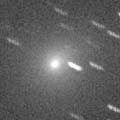
|
It was 14 mag on May 12 when appearing in the morning low sky (Michael Mattiazzo). Then it has been brightening as expected, and it was 11.3 mag in mid June around the perihelion passage (June 16, Juan Jose Gonzalez). In its last appearance, the comet unexpectedly brightened after the perihelion passage, and reached to the maximum brightness about 45 days after the perihelion passage. In this return, it continues brightening even after the perihelion passage, too. Now it is 10.2 mag (July 2, Juan Jose Gonzalez). The diameter was small as 1.5 arcmin in mid June, however, it became much larger rapidly in early July. Now it is so large as 5 arcmin. It will be 9 mag as expected from July to August. In the Northern Hemisphere, it keeps observable for a long time after this. Now it is observable all night, however, the altitude in the morning will be lower than 15 degree in early August. In the Southern Hemisphere, it is not observable until it becomes faint.
Date(TT) R.A. (2000) Decl. Delta r Elong. m1 Best Time(A, h)
July 23 8 59.62 80 34.5 1.516 1.351 60 10.4 18:40 (169,-33)
July 30 11 12.88 75 0.5 1.575 1.385 60 10.0 18:44 (165,-26)
|
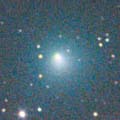
|
The Deep Impact mission succeeded on July 4. It had kept bright at 10 mag for two months since May until the impact, while getting diffused gradually. The central nucleus shining just after the impact was observed even on the ground. Mike Linnolt confirmed that the degree of condensation (DC) increased from 4 to 8 during 30 minutes. But the total magnitude brightened by only 0.5 mag. The nuclear magnitude brightened by 1-2 mag. The change was temporary. The comet almost returned to be the original state on the next day. Now it is 10.0 mag with a DC of 5 (July 5, Mike Begbie). Because the influence to the comet was very small, it will be fading as predicted. It will be fainter than 12 mag in September. The condition keeps good in the Southern Hemisphere. However, it will be lower than 20 degree in mid August in the Northern Hemisphere.
Date(TT) R.A. (2000) Decl. Delta r Elong. m1 Best Time(A, h)
July 23 14 16.71 -16 42.7 1.004 1.517 97 10.5 18:40 (160, 71)
July 30 14 33.43 -19 10.6 1.052 1.526 95 10.7 18:44 (147, 72)
|
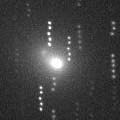
|
It brightened rapidly in early June, and reached to 8.9 mag on June 10 (Juan Jose Gonzalez). Then it stopped at 9 mag, and became unobseravble in late June in the Northern Hemisphere. It was visible still on July 4 (Michael Mattiazzo), however, it faded rapidly down to 12 mag, or fainter, on July 10 (Terry Lovejoy). Because it approached to the sun down to 0.54 AU at the perihelion passage on July 5, it can vanish soon. In the Southern Hemisphere, it will be higher after late July at dawn. But it will fade out rapidly. It is not observable until September in the Northern Hemisphere. Nucleus split was found on June 12 by many persons including Giovanni Sostero. The secondary component had been visible until June 22, however, became invisible on June 23 (Ernesto Guido, Giovanni Sostero).
Date(TT) R.A. (2000) Decl. Delta r Elong. m1 Best Time(A, h)
July 23 7 53.12 -9 37.7 1.327 0.677 30 10.7 5:33 (280, 2)
July 30 7 42.64 -10 43.2 1.416 0.776 32 11.5 5:29 (277, 9)
|
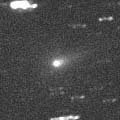
|
Although it was faint as 15.2 mag on Mar. 14 (Yuji Ohshima), it brightened in April, and finally it became bright enough to be visible visually, 12.3 mag on May 2 (Juan Jose Gonzalez). The comet keeps brightening, and now it is bright as 9.4 mag (July 6, Juan Jose Gonzalez). Now it is brighter than this ephemeris by 1 mag. It keeps slightly fainter than this ephemeris. It keeps 10 mag until July. However, it keeps locating very low in the morning. The altitude keeps lower than 20 deg until September when it becomes fainter than 12 mag. It will be higher than 30 deg after October, when it will be already fainter than 13 mag. It will pass only 0.5 degree by P/2005 JQ5 on Aug. 1. Then two 11-mag comets can be visible within a same field.
Date(TT) R.A. (2000) Decl. Delta r Elong. m1 Best Time(A, h)
July 23 4 51.85 16 10.1 1.473 1.076 46 10.9 5:33 (231, 21)
July 30 5 18.71 13 51.1 1.496 1.106 47 11.0 5:29 (233, 22)
|
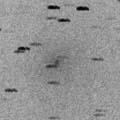
|
New periodic comet with a very short period of 4.4 years. It passed very close by the earth in June, about 0.1 AU. Although it was so faint as 17.5 mag in early May, it brightened rapidly, 13.5 mag on June 6, 12.0-12.5 mag on June 12 (Michael Jager), and became visible visually as bright as 10.3 mag on June 25 (Juan Jose Gonzalez). Because it was so close to the earth, it had a very large and faint coma with a diameter of 4-8 arcmin. Surprisingly, it was detected on survey images on June 24 as a very bright and large object, 8-9 mag with a diameter of 20 arcmin (Terry Lovejoy). It is appearing again in the morning sky. Although the brightness is uncertain, it is expected to be 11-14 mag, so maybe visible visually. However, because it is still close to the earth, 0.3 AU, it will be very large and diffused. Therefore, it will be hard to see visually, or take an image using a CCD camera, without clear sky. It will pass only 0.5 degree by 21P on Aug. 1. Then two 11-mag comets can be visible within a same field.
Date(TT) R.A. (2000) Decl. Delta r Elong. m1 Best Time(A, h)
July 23 5 41.35 12 36.5 0.247 0.829 36 11.1 5:33 (243, 15)
July 30 5 31.13 12 17.3 0.310 0.826 45 11.6 5:29 (237, 21)
|
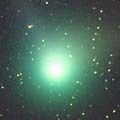
|
It was fantastic, so bright as 3.5 mag, so large as 30 arcmin, locating high overhead at its best time in early January. Then it has been getting fainter and smaller gradually, and 10.6 mag now (June 26, Juan Jose Gonzalez). The diameter is about 4 arcmin now. It became faint and small, however, it is still easy to see with a telescope. In the Northern Hemisphere, it keeps observable in good condition for a long time while the comet is bright enough visible visually until October when it becomes faint as 14 mag.
Date(TT) R.A. (2000) Decl. Delta r Elong. m1 Best Time(A, h)
July 23 13 39.08 24 57.9 2.869 2.786 75 11.7 18:40 (163, 28)
July 30 13 46.71 22 47.4 3.014 2.862 71 12.0 18:44 (157, 29)
|
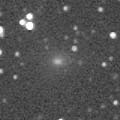
|
New comet. Although it is 14 mag by CCD observations, it is bright as 12.4 mag visually (July 8, Juan Jose Gonzalez). It keeps 12 mag until September. Because it moves in the northern sky, it is not observable in the Southern Hemisphere until when it becomes faint. In the Northern Hemisphere, it keeps locating very low in the morning sky. It will not be high until when it becomes faint.
Date(TT) R.A. (2000) Decl. Delta r Elong. m1 Best Time(A, h)
July 23 4 59.67 47 34.9 1.667 1.225 46 12.0 5:33 (212, -4)
July 30 5 48.65 50 39.0 1.635 1.186 46 11.8 5:29 (213, -9)
|
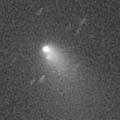
|
In January when it was visible in the Northern Hemisphere, it was an 11 mag small object. However, after it has gone to the southern sky, it reached to 8.0 mag, bright enough to be visible with binoculars, from March to April (Mar. 4 and Apr. 7, Alexandre Amorim). It must have started fading after mid April, however, it kept bright as 8.9 mag still on May 12 (Michael Mattiazzo), brighter than expected by 1 mag. Then, it had been very low even in the Southern Hemisphere, while it had been fading as 10-10.5 mag on May 31 and about 11 mag on June 15 (Terry Lovejoy). It brightened rapidly before the perihelion passage, but it is fading in moderate speed after the perihelion passage. Now it is 11.1 mag (July 2, Juan Jose Gonzalez). It is appearing in the morning sky after the long blank also in the Northern Hesmisphere. It keeps observable in good condition until winter when it becomes fainter than 18 mag. The split of the nucleus was found on June 25. The secondary nucleus was fainter than the primary by 0.7 mag, so both nucleus can be detected on CCD images. No effect of the split was found on the total brightness of the comet.
Date(TT) R.A. (2000) Decl. Delta r Elong. m1 Best Time(A, h)
July 23 1 39.34 16 52.2 1.623 1.930 91 12.0 5:33 (181, 38)
July 30 1 29.53 19 30.3 1.597 2.019 98 12.2 4:59 (180, 36)
|
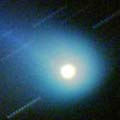
|
The brightness evolution had been slower than a typical comet since its discovery until the perihelion passage in early April. Although it kept bright as 8 mag from mid March to early May, it seems to start fading in mid May as expected, 8.4 mag on May 12 (Michael Mattiazzo). After this, it is not observable in the Northern Hemisphere until late September when it appears very low sky at dawn as 14 mag. It had been low until early July even in the Southern Hemisphere. Probably, the comet has faded out rapidly down to 12 mag while locating low. However, no observations have been reported since mid May, so it is uncertain how the comet is fading now. Unusually strong non-gravitational parameters are revealed by the orbital calculation, but the reason has not been revealed yet.
Date(TT) R.A. (2000) Decl. Delta r Elong. m1 Best Time(A, h)
July 23 6 49.20 -33 25.9 2.388 2.021 56 12.0 5:33 (293, 27)
July 30 6 58.82 -33 33.1 2.483 2.112 57 12.2 5:29 (292, 30)
|
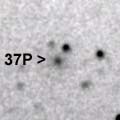
|
Although it was only 19 mag in January, it brightened as expected, and became visible visually at 12.5 mag on June 7 (John Drummond). Now it is 11.7 mag (July 1, Nicolas Biver). It will be visible as bright as 12 mag until September. In the previous return, it was 1.5 mag brighter than this ephemeris visually. So it can be around 11.0 mag visually at best in this return, too. The condition is good in the Southern Hemisphere. However, it keeps locating very low in the Northern Hemisphere. It is September when it becomes higher than 30 deg.
Date(TT) R.A. (2000) Decl. Delta r Elong. m1 Best Time(A, h)
July 23 16 15.22 -32 52.3 0.741 1.575 126 12.3 20:11 (180, 88)
July 30 16 27.61 -31 40.5 0.771 1.573 122 12.4 19:56 (180, 87)
|

|
It will reach to 9 mag in 2006 spring. In the Southern Hemisphere, it keeps observable until that. In the Northern Hemisphere, it is not observable until 2006 March, except it appears very low in the morning at 12 mag from late August to early September. After 2006 March, northern people can observe it for a long time while it is getting fainter. It had been brightening well as expected until 2005 March. It was 15.1 mag on Mar. 5 (Mitsunori Tsumura). However, no observations have been reported since mid March, so the current brightness is uncertain. Although it has been extremely low even in the Southern Hemisphere for a while, it will locate high again after July.
Date(TT) R.A. (2000) Decl. Delta r Elong. m1 Best Time(A, h)
July 23 5 23.51 -22 14.6 3.393 2.993 58 12.9 5:33 (271, 39)
July 30 5 29.53 -24 4.8 3.252 2.925 62 12.7 5:29 (271, 44)
|

|
It was 16.4 mag at the discovery in March (Mar. 12, R. H. McNaught), but it brightened up to 14.4 mag on June 6 (Yuji Ohshima). It is expected to be bright as 10 mag in early 2006. In the Southern Hemisphere, it keeps locating high until November while the comet is getting brighter gradually. In the Northern Hemisphere, it keeps locating very low around 15 deg high until September. So, it may be too hard to see visually for a long time.
Date(TT) R.A. (2000) Decl. Delta r Elong. m1 Best Time(A, h)
July 23 20 9.51 -40 2.9 2.166 3.140 160 13.0 0:08 ( 0, 85)
July 30 20 1.83 -40 6.0 2.110 3.071 157 12.9 23:28 ( 0, 85)
|

|
Appearing at dawn. It had been always brighter than 13 mag and visible visually all through the season in 2004. In 2005, it is observable in very good condition, almost overhead in the Northern Hemisphere from summer to winter. It can be a good target of observaions if it becomes active as in 2004. It was 14.2 mag on May 31 (Ken-ichi Kadota). In June, the nuclear magnitude was reported so faint as 16 mag. But it was bright and large, 12.8 mag with a diameter of 2.5 arcmin without central condensation on June 29 (Jiri Srba).
Date(TT) R.A. (2000) Decl. Delta r Elong. m1 Best Time(A, h)
July 23 2 15.26 23 7.7 5.822 5.751 80 13.5 5:33 (191, 31)
July 30 2 17.52 23 30.8 5.716 5.752 86 13.5 5:29 (185, 31)
|

|
It was bright as 7.5 mag in early January, easy to see with binoculars. However, it faded and got diffused rapidly in the evening sky after that. It faded to 10.7 mag on Mar. 15 visually (Alexandre Amorim), and 11.5 mag on Apr. 4 by CCD observation (Mitsunori Tsumura), then it became unobservable. It has been already appearing at dawn since mid June in the Southern Hemisphere, but no observations have been reported. It is appearing in the morning also in the Northern Hemisphere. It may be brighter than 14 mag and visible visually.
Date(TT) R.A. (2000) Decl. Delta r Elong. m1 Best Time(A, h)
July 23 4 31.49 -4 25.2 4.391 3.963 58 13.6 5:33 (243, 39)
July 30 4 32.23 -4 44.6 4.366 4.036 64 13.7 5:29 (238, 43)
|
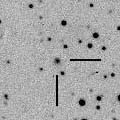
|
It brightened from 18 to 15 mag during one year from the end of 2003 to early 2005. The brightness evolution was much faster than that of a typical comet. After that, it kept 15-15.5 mag until May. Although it is not observable for a while, it will be getting higher again in August. It can be 13 mag and may be visible visually in next winter.
Date(TT) R.A. (2000) Decl. Delta r Elong. m1 Best Time(A, h)
July 23 7 44.21 45 13.3 6.450 5.552 25 14.8 5:33 (231,-25)
July 30 7 53.60 45 7.8 6.408 5.533 28 14.7 5:29 (230,-23)
|

|
New bright periodic comet discovered in 2004 spring. It had been bright at 15.0-15.5 mag from spring to summer in 2004. The ephemeris says it keeps brighter than 19 mag even around the aphelion, however, the comet had not been discovered before 2004. This suggested the comet became bright temporarily last year. But actually, it keeps the same brightness in 2005, too. Now it is 14.8 mag (May 15, Akimasa Nakamura). It will be bright at 14.5 mag until autumn. However, it locates very low, around 20 deg high, in the Northern Hemisphere. So it will be hard to see it visually.
Date(TT) R.A. (2000) Decl. Delta r Elong. m1 Best Time(A, h)
July 23 20 9.37 -35 44.0 2.065 3.056 164 14.9 0:08 ( 0, 89)
July 30 20 3.95 -36 18.0 2.091 3.068 160 15.0 23:30 ( 0, 89)
|
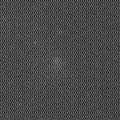
|
It is getting higher in the morning sky, however, it will be fading after this. It was 13.6 mag on May 12, as bright as expected (Michael Mattiazzo).
Date(TT) R.A. (2000) Decl. Delta r Elong. m1 Best Time(A, h)
July 23 4 12.85 10 57.0 2.459 2.096 57 14.9 5:33 (226, 31)
July 30 4 24.20 11 12.1 2.434 2.139 61 15.1 5:29 (223, 32)
|
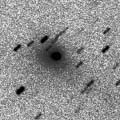
|
It kept 12.5-13.0 mag since November, and it was visible visually as 12.7 mag still on May 4 (Seiichi Yoshida). Then the altitude has been getting lower and lower. It will be unobservable in this return soon.
Date(TT) R.A. (2000) Decl. Delta r Elong. m1 Best Time(A, h)
July 23 10 3.89 21 35.4 2.972 2.115 26 15.0 18:40 (119, 3)
July 30 10 19.65 20 4.0 3.032 2.147 24 15.2 18:44 (115, 1)
|
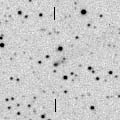
|
It brightened rapidly from 19 to 17 mag in early 2004. But it is in normal state now, brightening gradually. It keeps 15-16 mag for a long time until early 2007. Although it does not locate very high in the Northern Hemisphere, it is also visible visually. Visual brightness is 14.3 mag on May 7 (Juan Jose Gonzalez) and 14.2 mag on June 7 (John Drummond), very small with a diameter of 0.2-0.6 arcmin.
Date(TT) R.A. (2000) Decl. Delta r Elong. m1 Best Time(A, h)
July 23 15 21.76 -20 44.2 2.583 3.126 113 15.3 19:17 (180, 76)
July 30 15 24.12 -21 3.2 2.664 3.118 107 15.4 18:52 (180, 76)
|

|
It keeps 15.5 mag for a long time until 2006 January. Good condition in the Southern Hemisphere, but not observable in the Northern Hemisphere. It will be observable also in the Northern Hemisphere after 2006 August, when it is already faint as 16.5-17 mag.
Date(TT) R.A. (2000) Decl. Delta r Elong. m1 Best Time(A, h)
July 23 0 32.43 -66 29.2 3.331 3.912 117 15.3 4:29 ( 0, 59)
July 30 0 39.57 -68 4.2 3.316 3.897 117 15.3 4:09 ( 0, 57)
|
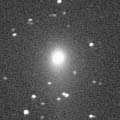
|
Although it had been rather large, well condensed, and easy to see until February, it became diffused in March. It was bright visually, 12.8 mag still on May 4 (Seiichi Yoshida). The fading after the perihelion passage is slow, and it will keep visible at 14 mag for a while after this. However, no visual observations have been reported since mid May. In the Northern Hemisphere, it is getting lower slowly in the evening sky, but it will be higher than 20 deg still in mid August.
Date(TT) R.A. (2000) Decl. Delta r Elong. m1 Best Time(A, h)
July 23 10 32.08 53 44.4 3.965 3.299 43 15.3 18:40 (147,-14)
July 30 10 45.91 51 59.5 4.043 3.357 41 15.4 18:44 (144,-15)
|
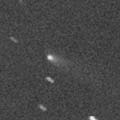
|
Moving northwards, so it will locate high in the Northern Hemisphere after this. It will be observable in good condition at 15.5 mag from July to November. Maybe it will be visible visually.
Date(TT) R.A. (2000) Decl. Delta r Elong. m1 Best Time(A, h)
July 23 2 13.96 14 23.1 1.245 1.524 84 15.5 5:33 (192, 40)
July 30 2 31.01 17 29.1 1.200 1.515 85 15.4 5:29 (189, 37)
|
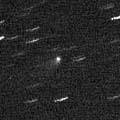
|
It was faint as 16.5 mag in early February. Then it has been brightening as expected, and reached to 15.2 mag in late April (Apr. 27, Ken-ichi Kadota). It will be observable in good condition at 14.5-15 mag until mid July. Because it locates high, it will be visible visually with a large telescope when the sky is clear. It was observed visually at 15.0 mag on May 7 (Shigeki Murakami). It brightened furthermore by 1 mag, 14.1 mag on June 13 by CCD observation (Yusuke Ezaki).
Date(TT) R.A. (2000) Decl. Delta r Elong. m1 Best Time(A, h)
July 23 14 9.90 14 51.3 3.337 3.403 85 15.4 18:40 (169, 40)
July 30 14 3.88 14 7.3 3.473 3.407 77 15.5 18:44 (157, 38)
|
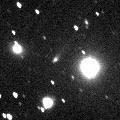
|
It is brighter than discovery report by 1 mag. Actually, it was 15.7 mag on June 26 (Giovanni Sostero). Sharply and strongly condensed with a narrow long tail. It will be 15.5 mag both in 2005 summer and 2006 summer. It moves southwards, so the condition in the Northern Hemisphere is better in 2005.
Date(TT) R.A. (2000) Decl. Delta r Elong. m1 Best Time(A, h)
July 23 16 30.48 53 1.7 3.660 3.848 92 15.7 20:25 (180, 2)
July 30 16 28.12 50 36.5 3.660 3.831 91 15.7 19:55 (180, 5)
|
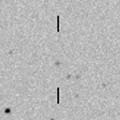
|
Recovery of a peculiar asteroid 2004 FS101 discovered in 2004 spring. Although it was 18 mag in mid January, it brightened to 16-16.5 mag in mid May. The brightness evolution was rather faster than that of a typical comet. It will be 14.5 mag around 2006 January, although it will be rather low for the northern observers. It keeps observable at 15-16 mag for a long time from 2005 spring to the end of 2006. Because it moves in the northern sky, it keeps observable for a long time in the Northern Hemisphere.
Date(TT) R.A. (2000) Decl. Delta r Elong. m1 Best Time(A, h)
July 23 13 12.93 48 50.5 4.101 3.799 65 15.9 18:40 (165, 4)
July 30 13 16.09 48 30.6 4.117 3.765 62 15.9 18:44 (161, 2)
|

|
It was observed as 17.0 mag on July 10, as bright as expected. It will be 15.5 mag from September to December. It is already high in the morning sky.
Date(TT) R.A. (2000) Decl. Delta r Elong. m1 Best Time(A, h)
July 23 0 21.94 -1 38.5 2.092 2.693 115 16.8 4:19 (180, 57)
July 30 0 25.92 -1 34.1 1.992 2.666 121 16.6 3:56 (180, 57)
|
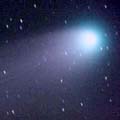
|
Although it had been locating low for a while, now it is getting higher again. Fading slowly, and still bright as 16 mag.
Date(TT) R.A. (2000) Decl. Delta r Elong. m1 Best Time(A, h)
July 23 2 7.62 61 40.5 5.717 5.499 72 16.9 5:33 (184, -7)
July 30 2 6.86 62 14.8 5.703 5.565 77 17.0 5:29 (181, -7)
|

|
New comet. It will be 17 mag in September.
Date(TT) R.A. (2000) Decl. Delta r Elong. m1 Best Time(A, h)
July 23 1 21.79 4 12.8 1.193 1.692 99 17.7 5:18 (180, 51)
July 30 1 41.68 3 27.4 1.135 1.672 101 17.5 5:11 (180, 51)
|
|
![]()
 C/2005 E2 ( McNaught )
C/2005 E2 ( McNaught ) 29P/Schwassmann-Wachmann 1
29P/Schwassmann-Wachmann 1 C/2003 K4 ( LINEAR )
C/2003 K4 ( LINEAR ) C/2003 WT42 ( LINEAR )
C/2003 WT42 ( LINEAR ) P/2004 F3 ( NEAT )
P/2004 F3 ( NEAT ) 10P/Tempel 2
10P/Tempel 2 32P/Comas Sola
32P/Comas Sola 117P/Helin-Roman-Alu 1
117P/Helin-Roman-Alu 1 C/2004 L2 ( LINEAR )
C/2004 L2 ( LINEAR ) C/2004 Q1 ( Tucker )
C/2004 Q1 ( Tucker ) P/2005 K3 ( McNaught )
P/2005 K3 ( McNaught ) C/2004 K1 ( Catalina )
C/2004 K1 ( Catalina ) C/2005 K1 ( Skiff )
C/2005 K1 ( Skiff ) C/2005 B1 ( Christensen )
C/2005 B1 ( Christensen ) 101P/Chernykh
101P/Chernykh C/2001 Q4 ( NEAT )
C/2001 Q4 ( NEAT ) C/2005 N5 ( Catalina )
C/2005 N5 ( Catalina )![]()





















